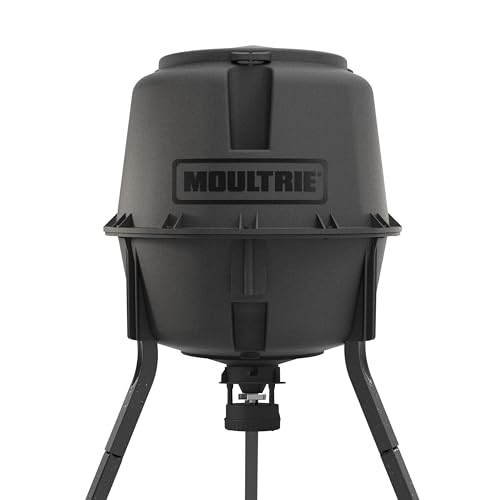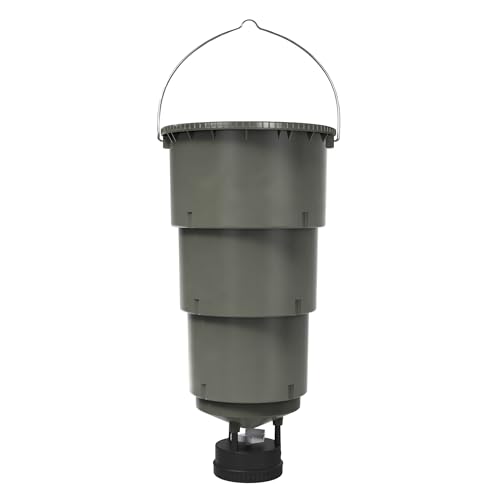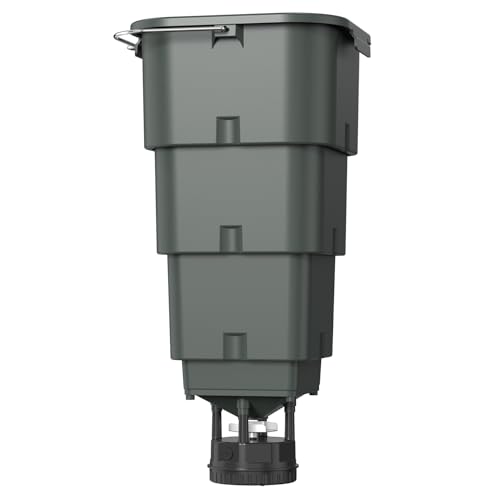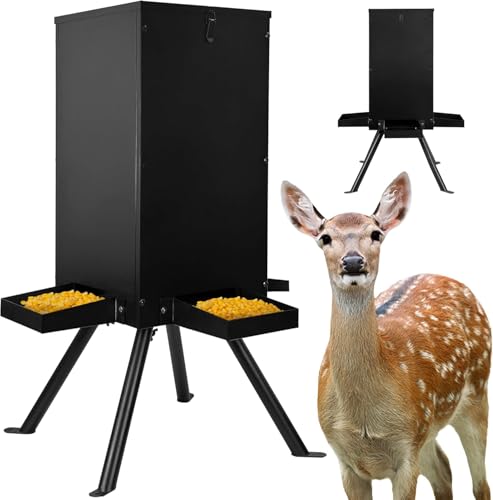
Deer feeders are essential tools for hunters, wildlife watchers, and those who simply want to support local deer populations.
They help attract deer to a specific location, making it easier to observe or hunt them while also providing essential nutrients that might be scarce in their natural environment.
With the right deer feeder, you can enjoy more successful hunting trips, better wildlife photography opportunities, or simply the satisfaction of supporting your local deer population.
Top Picks of The Best Deer Feeders on The Market
- Full 360° Feed Coverage: Broadcast spin plate spreads corn and supplements in every direction, making it ideal for open fields and wide feeding areas.
- Programmable Digital Timer: Easy-to-use timer lets you set up to 10 feeding times a day, giving you total control over deer feeding schedules.
- Heavy-Duty 250lb Hopper Capacity: Holds up to 250 lbs of corn or protein pellets, reducing refill frequency and ensuring consistent wildlife feeding over longer periods.
- Battery-Free Gravity Feed Design: Operates without batteries or electronics, offering reliable feed distribution without maintenance or risk of mechanical failure in remote locations.
- 30gal Nesting Hopper w/ Gravity Feeder
- 30gal Nesting Hopper w/ Gravity Feeder
- REMOTE PROGRAMMING VIA MOULTRIE APP: Upgrade your game management with Bluetooth connectivity and the Moultrie mobile app. Set feed times, durations, and frequency from up to 300 feet away—no need to visit the feeder directly. Gain full control without disturbing your hunting area or leaving scent behind.
- DURABLE 200LB. UV-RESISTANT POLYMER HOPPER: Engineered for reliability, the 30-gallon tapered hopper holds up to 200 lbs of feed. Constructed from rugged, UV-resistant polymer for long-term use in sun, rain, and wildlife-heavy environments. Easy ground-level access for fast filling.
- HIGH PERFORMANCE – Attract and pattern deer and other game with the Wildgame Innovations Quick-Set feeder with timer; Durable and easy to use, this tripod pellet and corn feeder is equipped with a built-in funnel, that ensures accurate feed dispersal
- LARGE CAPACITY – The Wildgame Innovations Quick-Set deer feeder offers a 225-pound capacity and a 30-foot feed radius; You can fill your hunting game feeder with plenty of corn or pellet feed without worrying about clogs or hang-ups
- All‑In‑One Hanging Feeder Design – Compact, easy‑to‑install hanging deer feeder with an integrated digital timer, 30 lb collapsible hopper, and durable build that ensures dependable feeding performance in hunting plots, game ranches, and remote wildlife areas.
- Bluetooth‑Enabled Control – Adjust feeding schedules, motor run time, and feed settings directly from your smartphone using the free Moultrie Mobile App. No subscription required, giving you seamless control from a distance without manual adjustments.
- 【Expertly Crafted Design】Material: Plastic.The housing of the hanging deer feeder is crafted from engineering plastic, offering impact and weather durability. At its core, it features a motor and an intelligent timing module, paired with a galvanized steel rotating disc. This robust design ensures wear resistance, maintaining structural integrity and smooth operation even under prolonged exposure to hard feed such as corn.
- 【5-Gallon Hanging Game Feeder】Say goodbye to the hassle of frequent refilling! With its generous 5-gallon capacity, this hanging feeder reliably serves your hunting grounds. A single fill provides sustained nutritional support for deer over an extended period, allowing you to maintain your watch with peace of mind—no need for constant trips to refill.
- Durable Carbon Steel Construction – The Metal Hanging Deer Feeder Box is made from carbon steel with a sprayed surface for reliable daily use. The sturdy build supports outdoor feeding needs on farms, ranches, and deer camps while helping maintain stable feed output for deer, horses, cattle, sheep, and other livestock.
- 11-Gallon Large Capacity – This Heavy Duty Deer Feeding Station features a 41.6L/11-gallon capacity, providing enough space for extended feeding cycles. It helps reduce refill frequency and supports continuous feeding whether used as a Gravity Deer Feeder Automatic Dispenser or a general Hunting Game Feeder.
- 【Heavy-Duty, Weather-Resistant Construction】Crafted from premium,rust-resistant,thickened galvanized steel plates,this feeder is engineered to withstand the toughest outdoor conditions.Its robust, durable construction ensures it will endure for seasons to come.With a generous 14 gallon capacity(50-80lbs capacity), it offers ample room for feed, reducing the need for frequent refills while providing a steady, automatic supply of food to attract and nourish deer in your area.(US Patent Pending)
- 【Efficient 4-Port Feeding System】Designed for optimal feeding, this automatic deer feeder features a practical four-port tray system, allowing multiple deer to feed at once. The strategically designed drainage bottoms ensure water drains quickly, keeping the feed dry and fresh. This innovative design prevents sogginess. Perfect for attracting or feeding deer, making it an excellent choice for hunters and wildlife enthusiasts.
What is a Deer Feeder
A deer feeder, as the name suggests, is a device used to feed deer and other similar wildlife.
They come in various designs, including gravity feeders, timed feeders, and spin feeders.
Some are simple troughs, while others are sophisticated devices with timers and mechanisms to dispense food at set intervals.
Regardless of the design, the main purpose of a deer feeder is to provide a consistent food source for deer, which can help attract them to a certain area.
Comparing the Top Deer Feeders of 2026 in Detail
BOSS Buck Deer Feeder

Product Description
The BOSS Buck Deer Feeder is a gravity-fed unit that boasts an impressive 200-pound capacity.
It’s designed with a double-walled hatch lid to keep out moisture and pests, ensuring the feed remains fresh.
The durable construction guarantees longevity while the feeding ports are adjustable for controlling the flow of feed.
Key Features
- 200-pound capacity
- Gravity-fed system
- Double-walled hatch lid
- Adjustable feeding ports
- Durable construction
Wildgame Innovations Deer Feeder

Product Description
The Wildgame Innovations Deer Feeder is a tripod feeder with a digital timer that allows you to program up to 4 feed times per day. This feeder has a 225-pound capacity and features a built-in funnel to reduce feed waste.
Key Features
- 225-pound capacity
- Up to 4 programmable feed times per day
- Built-in funnel to reduce waste
- Digital timer
- Tripod design for stability
Moultrie Deer Feeder

Product Description
The Moultrie Deer Feeder stands out with its quick-lock technology, making setup a breeze. It’s a versatile feeder with customizable run times and a metal spin plate for increased durability.
It can hold up to 150 pounds of feed and offers a programmable timer for up to 6 different feed times per day.
Key Features
- 150-pound capacity
- Quick-lock technology for easy setup
- Customizable run times
- Programmable timer for up to 6 feed times per day
- Metal spin plate for durability
Bank Outdoors Deer Feeder
Product Description
The Bank Outdoors Deer Feeder is a high-capacity, gravity-fed feeder designed for large deer populations. It can hold up to 300 pounds of feed and features a waterproof lid to keep the feed dry. Its unique gravity design ensures deer have access to fresh food at all times.
Key Features
- 300-pound capacity
- Gravity-fed design
- Waterproof lid
- Large feeding ports
- Designed for large deer populations
REDNEK Deer Feeder
Product Description
The REDNEK Deer Feeder is a versatile and durable option that can hold up to 225 pounds of feed. It features a gravity-fed design and a weatherproof lid to keep the feed fresh and dry. The feeder also has large feeding ports that can accommodate several deer at once.
Key Features
- 225-pound capacity
- Gravity-fed design
- Weatherproof lid
- Large feeding ports
- Durable construction
Check Out: Best Deer Atttractant
Factors to Consider When Buying a Deer Feeder
Deer feeders are essential tools for wildlife enthusiasts, hunters, and landowners looking to attract deer to their property.
They help in managing the deer population, improving herd health, and offering a reliable source of nutrition for these majestic creatures.
However, buying a deer feeder isn’t as straightforward as it may seem. Several factors come into play, influencing the effectiveness and suitability of a deer feeder for your specific needs and environment.
In this section we’ll guide you through these considerations, assisting you in making an informed purchase.
Finding a Quality Deer Feeder: A Buyer’s Guide
Before delving into the specifics, it’s important to understand that not all deer feeders are created equal.
The market is flooded with different types, sizes, and designs, each with its unique features and benefits.
Your choice should ultimately align with your goals, the local deer population, and the prevailing environmental conditions.
How to Pick the Right Deer Feeder
Durability
The first factor to consider is durability. Deer feeders are typically placed outdoors, exposed to various elements.
Hence, they need to be robust enough to withstand diverse weather conditions. Look for feeders made from heavy-duty materials, preferably rust-resistant metal frames. The more durable the feeder, the longer it will last, providing value for money.
Waterproofing
Waterproofing is another crucial feature to consider. Rain or snow can spoil the feed, making it unpalatable to deer.
It could also lead to the growth of mold, which can be harmful to the deer. Therefore, make sure the feeder has adequate protection against water ingress.
Portability
Depending on your needs, you might have to move the feeder around. In such cases, portability becomes an essential factor.
Some feeders are lightweight and designed for easy transportation, while others are more stationary and heavy-duty.
Size
The size of the feeder you choose largely depends on the deer population in your area. If you have a large number of deer visiting your property, you may need a larger feeder. On the other hand, a smaller feeder would suffice for a smaller population.
Design
The design of the feeder plays a significant role in its functionality. Some feeders are equipped with a spinning base that scatters the feed, attracting more deer. Others have a more straightforward design where the deer have to access the feeder directly to get the food.
Feed Capacity
Lastly, consider the feed capacity of the feeder. Larger capacity means less frequent refilling, which could be advantageous if the feeder location is far from your storage area. However, keep in mind that the feed should be fresh to attract deer, so don’t overfill the feeder.
Types of Deer Feeders
Gravity Feeders
Gravity feeders work by releasing food onto a plate or trough using the force of gravity. They are simple, reliable, and require little maintenance since they have no mechanical parts.
Electronic Feeders
Electronic feeders use a motor to dispense food at preset times. This type of feeder allows you to control the amount of food dispensed and the feeding schedule, but they require a power source and regular maintenance.
Tripod Feeders
Tripod feeders are sturdy and can hold a lot of food. They are typically easy to fill and can be used with various types of feed. However, they can be challenging to move due to their size and weight.
Hanging Feeders
Hanging feeders are suspended from trees or structures. They are usually lightweight, easy to move, and harder for pests to access. However, they may not be suitable if there are no suitable structures to hang them from.
In conclusion, buying a deer feeder involves careful consideration of several factors, including durability, waterproofing, portability, size, design, and feed capacity. Understanding these factors and assessing your specific needs will ensure you choose a deer feeder that serves you and the local deer population effectively.
FAQs
What is the best type of deer feeder to use?
The best type of deer feeder to use depends on your specific needs, location, and the local deer population. Gravity feeders are easy to use and maintain, but automatic feeders offer more control over feeding times.
How often should I refill a deer feeder?
This depends on the size of your feeder, the number of deer you’re feeding, and the time of year. However, a good rule of thumb is to check your feeder every two weeks.
Where is the best place to put a deer feeder?
Deer feeders should be placed in quiet, remote areas where deer feel safe. This could be along a tree line, near a water source, or in a clearing.
Is there any special maintenance required for deer feeders?
Most deer feeders require minimal maintenance. However, it’s important to regularly check your feeder for any damage, ensure it’s clean, and the feed is fresh.
How do I protect my deer feeder from the elements?
Most deer feeders are designed to withstand outdoor conditions. However, you can further protect your feeder by placing it under a tree or installing a cover over it.
What is the best commercial deer feeder?
Based on our research, the Moultrie Deer Feeder stands out as one of the best commercial deer feeders due to its high capacity, durability, and programmable features.
Are gravity deer feeders any good?
Yes, gravity deer feeders are a great option as they require less maintenance than automatic feeders and allow deer to eat at their own pace.
Should deer feeder be in field or woods?
This depends on your specific situation. However, placing your feeder at the edge of a field near cover can often yield the best results.
Is it better to hunt deer in a stand or on the ground?
Both methods can be effective. Hunting from a stand can give you a better view and keep you out of a deer’s line of sight, while hunting on the ground allows more mobility.
What is a deer’s favorite forage?
Deer typically prefer broadleaf weeds and other native forages. In terms of supplemental feeding, they seem to enjoy corn, oats, and specialty deer feeds.
Should I try calling deer when hunting over a feeder?
Calling can be an effective way to attract deer. However, it’s important to use calls sparingly and only when you’re sure a deer is out of sight.
How often will deer visit a feeder?
This can vary greatly depending on the time of year, availability of natural food sources, and the local deer population. However, it’s common to see deer visit a feeder daily if there’s a consistent food supply.















